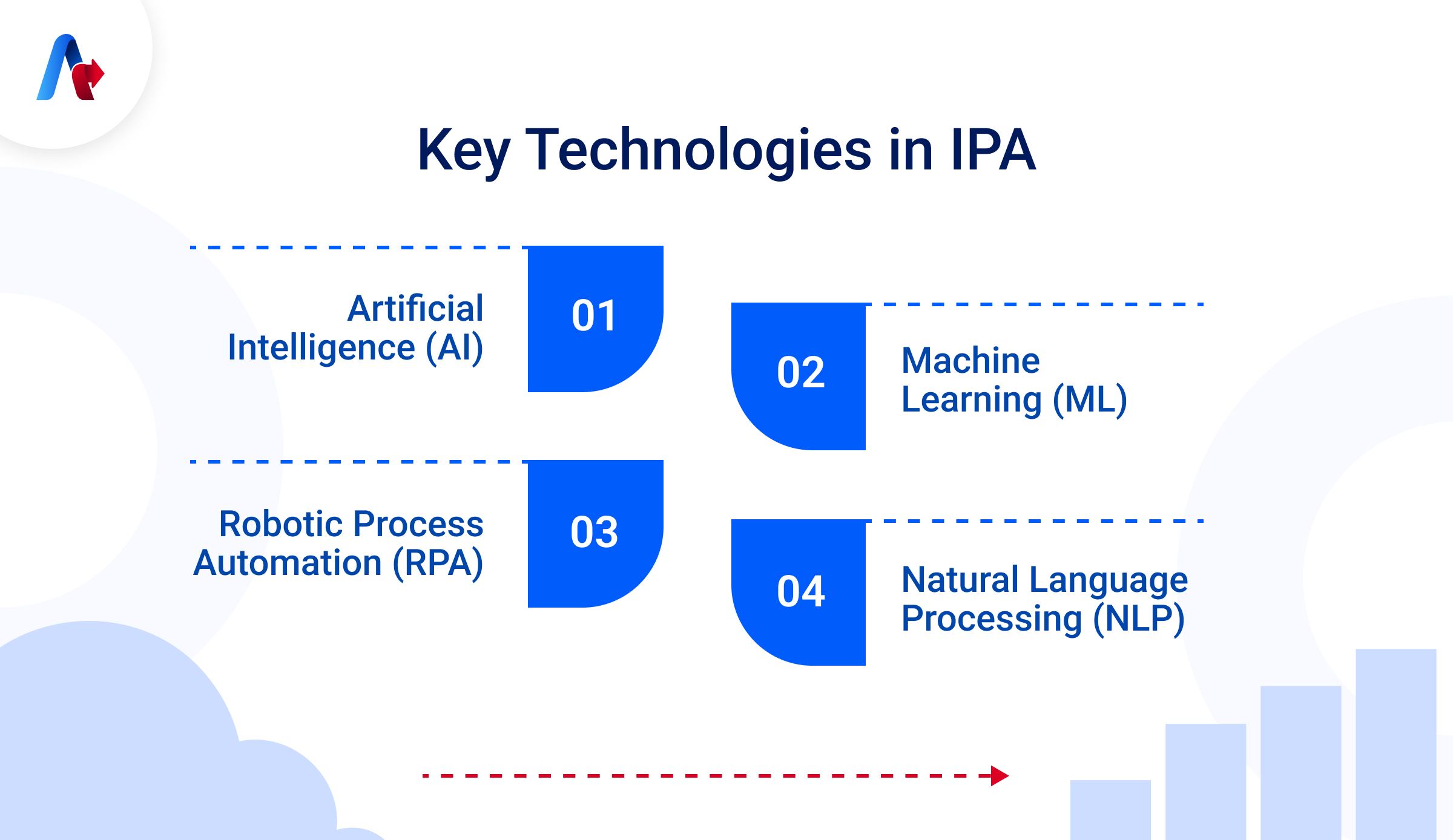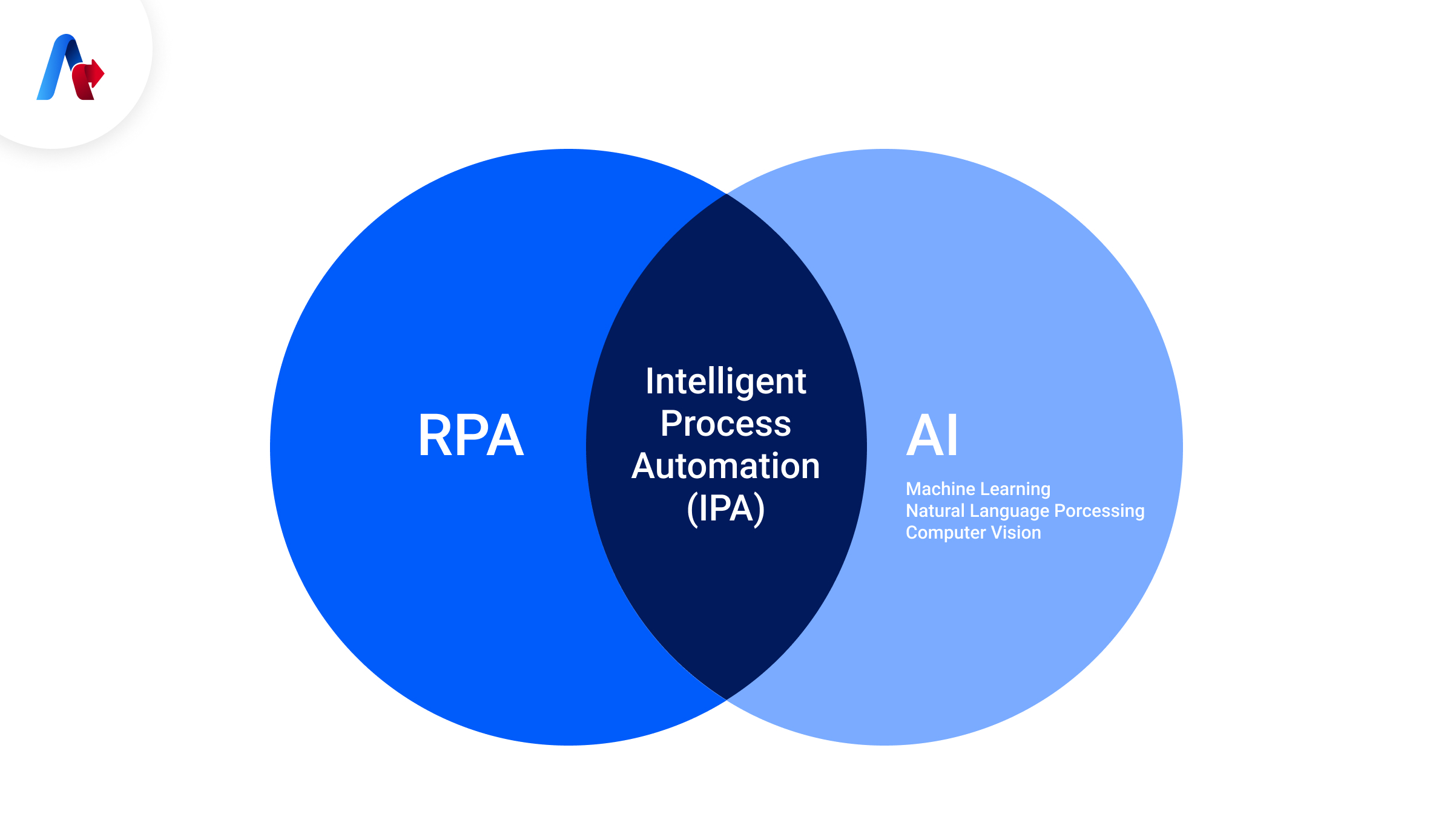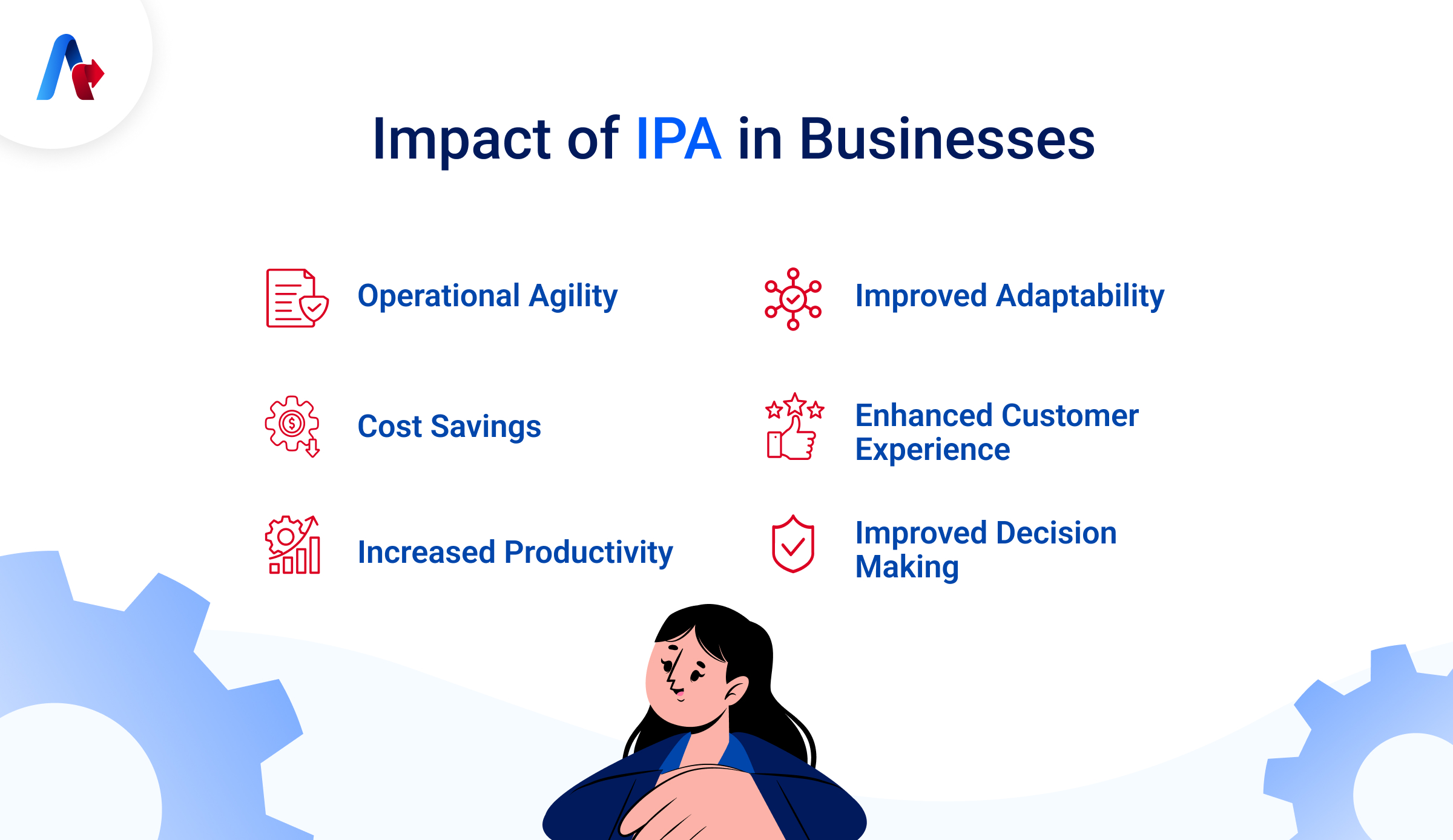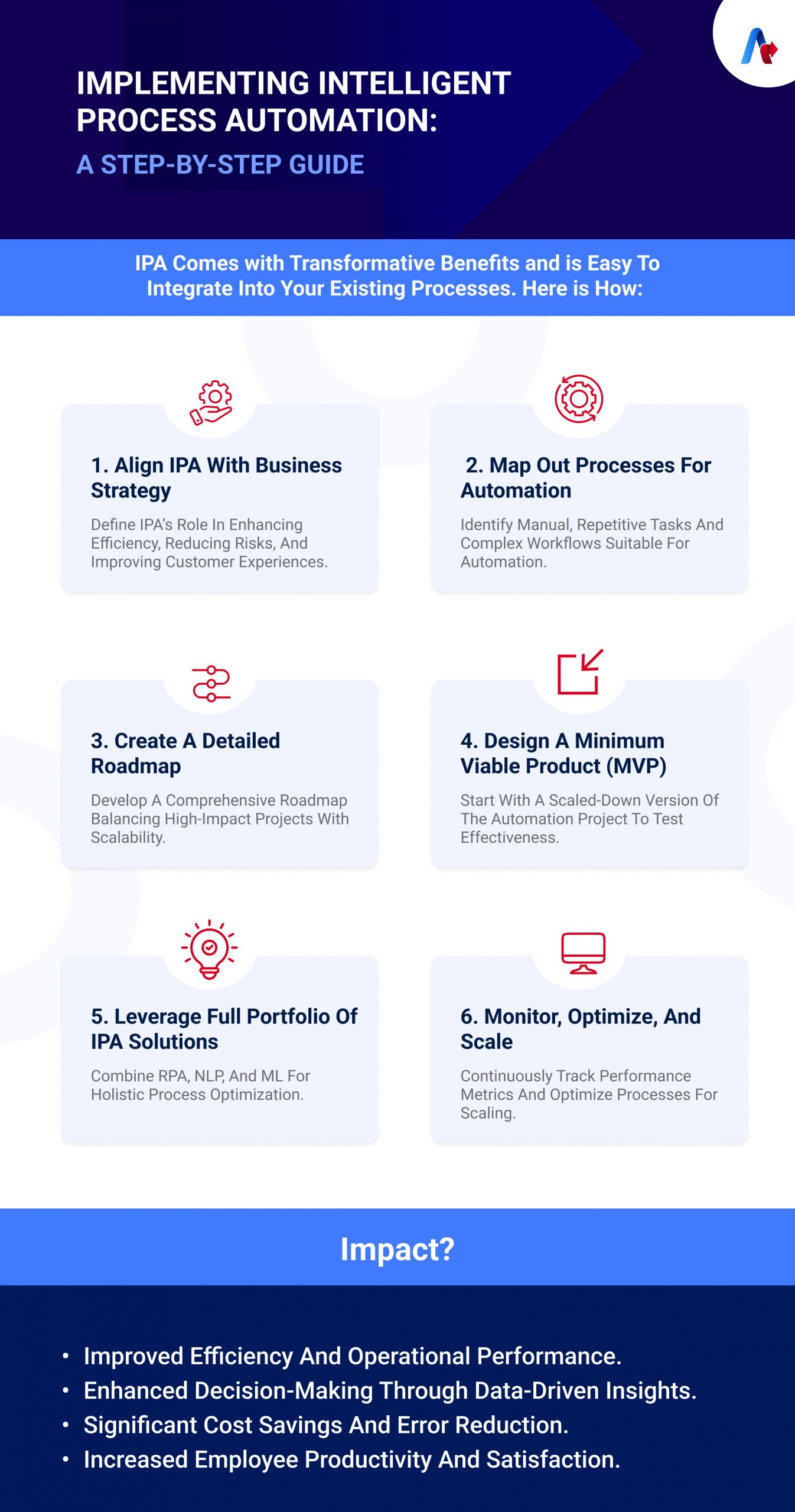Intelligent Process Automation
BLOG
11 min read
Exploring the Power of Intelligent Process Automation: Advantages, Implementation Steps, and Key Technologies
Business leaders today face constant pressure to boost profitability, enhance customer experiences, and secure strong returns on investment. As digital transformation accelerates, the adoption of advanced technologies like machine learning (ML), natural language processing (NLP), and artificial intelligence (AI) is rapidly reshaping how businesses operate. In fact, the global market for AI is projected to reach $200 billion by 2026, with 85% of enterprises expected to integrate AI, ML, and NLP into their processes by the same year.
At the forefront of this transformation is Intelligent Process Automation (IPA)—a dynamic solution that addresses the complex operational challenges many organizations face today.
By blending AI-driven capabilities such as deep learning and cognitive automation with traditional automation techniques, IPA enables companies to automate between 50-70% of their tasks, achieve 20-35% cost savings, and reduce process times by 50-60%.
The result? Businesses not only enhance productivity but also see significant improvements in decision-making, operational efficiency, and risk management.
In this blog, we’ll dive deeper into the world of IPA, uncovering its advantages, implementation steps, and the key technologies driving its success.
What is Intelligent Process Automation?
Intelligent Process Automation (IPA) is an advanced form of automation that combines traditional rule-based automation with emerging technologies like artificial intelligence (AI), machine learning (ML), and cognitive computing. Unlike basic automation, which follows predefined rules, IPA enables systems to learn and adapt over time, making smarter decisions and handling complex tasks with minimal human intervention. It automates repetitive, time-consuming processes while improving accuracy, efficiency, and decision-making. By integrating capabilities such as natural language processing and computer vision, IPA drives more intelligent, agile, and scalable business operations.
Technologies and Their Application in Intelligent Process Automation
Intelligent Process Automation (IPA) blends several advanced technologies to streamline business operations and improve efficiency. These technologies work together to automate processes, reduce errors, and drive smarter decision-making. Below is a breakdown of the main technologies that power IPA and their unique contributions.

01. Artificial Intelligence (AI)
Artificial Intelligence (AI) enhances decision-making and pattern recognition by simulating human intelligence, while Process Mining revolutionizes process management by analyzing and tracking processes using data from existing systems. Unlike traditional methods, which rely on subjective observations and interviews, Process Mining offers a comprehensive, data-driven view of how processes function. By connecting directly to source systems, it provides continuous insights, allowing businesses to focus on automating, improving, and tracking processes more effectively, leading to better outcomes and optimized workflows, such as in finance where AI is used for fraud detection.
02. Machine Learning (ML)
Machine Learning (ML) enhances over time by learning from data, while Intelligent Document Processing (IDP) automates the extraction and understanding of information from various types of documents. Unlike traditional methods, which were limited to basic text extraction, modern IDP leverages AI and ML to process structured, semi-structured, and unstructured documents with human-like comprehension. This shift enables organizations to integrate document processing into critical workflows, enhancing predictive maintenance in manufacturing and streamlining data management in legal and healthcare settings, making information actionable exactly when needed.

03. Natural Language Processing (NLP)
Natural Language Processing (NLP) and Communication Mining work together to extract meaningful insights from unstructured communication data, enabling machines to understand and respond to human language effectively. Advanced NLP models, like Large Language Models (LLMs), go further by handling complex text generation and comprehension tasks. Communication Mining refines business communications by transforming unstructured messages into actionable data, improving customer service through chatbots, and enhancing internal processes. These technologies facilitate content creation, complex query resolution, and efficient decision-making across industries.
04. Robotic Process Automation (RPA)
Robotic Process Automation (RPA) automates repetitive tasks using software robots, reducing errors in processes like data entry. Complementing RPA, Computer Vision enables computers to identify and understand objects and people in images and videos, mimicking human visual perception. This technology plays a crucial role in modern automation by enhancing quality inspections in manufacturing and automating document processing. Whether run in the cloud or on-premises, Computer Vision's ability to replicate human sight and comprehension makes it integral to various innovations and solutions across industries.
Simplify your workflow. Automate your tasks effortlessly today!
Get StartedTransformative Benefits of Intelligent Process Automation (IPA)
Intelligent Process Automation Solutions are transforming the way businesses operate by expanding the possibilities of traditional automation. Here are some key intelligent process automation benefits that companies can leverage to streamline operations and drive growth:

01. Increased Productivity
By automating repetitive tasks, IPA frees up employees to focus on more valuable, strategic work. This shift not only improves employee productivity but also enhances overall operational efficiency, allowing businesses to accomplish more with the same resources.
02. Cost Savings
Intelligent process automation solutions optimize workflows across the organization, leading to substantial cost reductions. With faster and more accurate processes, businesses can achieve significant savings while ensuring a quicker return on investment (ROI).
03. Improved Decision-Making
IPA solutions connect and integrate various systems, enabling better data capture and retrieval. This allows businesses to make more informed and timely decisions, improving the effectiveness of their strategies and reducing the risk of errors.
04. Enhanced Customer Experience
Faster response times, greater accuracy, and consistent results are key IPA automation benefits that directly improve customer experience. By automating customer-facing processes, businesses can deliver high-quality service more efficiently, driving customer satisfaction and loyalty.
05. Improved Adaptability
IPA solutions are designed to scale while maintaining strict security and compliance standards. They help businesses handle unstructured data using technologies like optical character recognition (OCR), allowing for more flexible and adaptive operations in dynamic environments.
06. Operational Agility
Intelligent process automation solutions can convert unstructured data into structured formats that RPA systems can manage. By enhancing workflows with IPA, businesses can significantly boost operational agility and streamline processes, resulting in increased efficiency and better outcomes.
Strategies for Successful Implementation of Intelligent Process Automation (IPA)
Implementing Intelligent Process Automation (IPA) requires a structured approach to ensure it delivers maximum value. Here are the essential steps to guide your IPA journey:

01. Align IPA with Business Strategy
Before diving into automation, it’s crucial to clearly define IPA’s role within the overall business strategy. Start by identifying key areas where automation can bring the most value, such as enhancing efficiency, reducing operational risks, or improving customer experiences. Understanding how IPA fits into your long-term goals will allow for better decision-making and prioritization of tasks
02. Map Out Processes for Automation
Begin by identifying the processes that are most suitable for automation. This includes manual, repetitive tasks, as well as more complex workflows that involve multiple systems or unstructured data. Mapping out these processes helps to pinpoint where IPA can deliver quick wins and provides a clear path for larger transformations.
03. Create a Detailed Roadmap
Once processes are identified, develop a comprehensive roadmap that outlines all areas where IPA can be implemented. This roadmap should balance high-impact projects with the feasibility of scaling automation initiatives. A phased approach, starting with pilot projects and scaling based on success, is key to ensuring sustainable implementation.
04. Design a Minimum Viable Product (MVP)
To avoid being overwhelmed by complex implementation, start with an MVP—a scaled-down version of the automation project that addresses key processes or workflows. This allows you to test the effectiveness of IPA in real-time, gather feedback, and make necessary adjustments before full-scale deployment.
05. Leverage Full Portfolio of IPA Solutions
Don’t limit automation to just one technology. Combine multiple intelligent automation tools, such as Robotic Process Automation (RPA), Natural Language Processing (NLP), and Machine Learning (ML), to achieve holistic optimization. Integrating these technologies ensures maximum impact and seamless end-to-end process automation.
06. Monitor, Optimize, and Scale
After the initial implementation, continuous monitoring is essential to measure the performance of the automation. Track the impact on efficiency, cost savings, and error reduction. Use this data to optimize processes further and scale IPA initiatives across the organization.
Following these steps will ensure that IPA is effectively integrated into your organization, driving significant improvements in efficiency and operational performance.
Revolutionize your business processes with Intelligent Process Automation
Connect with ExpertsThe Impact of IPA Automation on Business: Real-World Use Cases and Examples
Intelligent process automation (IPA) is transforming businesses across industries by automating complex tasks and streamlining workflows. With numerous intelligent automation examples, companies are experiencing improved efficiency, reduced costs, and better decision-making. This section highlights some of the key intelligent process automation use cases to showcase how IPA is delivering tangible value in real-world scenarios.

01. Process Automation in Automobile
Accelirate implemented automation solutions for an automobile services provider, resulting in a 30% increase in productivity and an ROI of $870K. By streamlining workflows and automating routine tasks, the provider was able to enhance service delivery and customer satisfaction significantly. Read more about this case study here.
02. Payroll Automation in Manufacturing
In the manufacturing sector, Accelirate helped automate payroll processes, leading to increased efficiency and accuracy. The implementation reduced processing time significantly, allowing HR teams to focus on strategic initiatives rather than manual data entry. Learn more about this automation solution here.
03. Machine Learning for Patient Enrollment Processes in Healthcare
A healthcare organization leveraged machine learning combined with RPA to automate their enrollment processes. This integration not only sped up the onboarding of new patients but also improved data accuracy, resulting in better patient experiences and operational efficiency. Read about this innovative approach here.
04. KYC Automation Enhancement for U.S. Bank
A leading U.S. bank utilized Accelirate’s automation solutions to enhance their Know Your Customer (KYC) processes, achieving scalability and reducing the time spent on compliance tasks. This project not only streamlined operations but also ensured regulatory compliance efficiently. Find out more about this case study here.
Pave the Way for a Competitive Edge with Intelligent Process Automation
Intelligent Process Automation (IPA) has the power to change how organizations operate by enhancing efficiency, productivity, and decision-making. With the help of AI and Automation experts like Accelirate, businesses can streamline complex workflows, reduce errors, and unlock new growth opportunities. However, successful IPA implementation requires careful planning and execution. Organizations must prioritize process identification, data quality, employee training, and a robust change management strategy. By adopting a holistic approach and embracing the potential of IPA, businesses can position themselves for long-term success in an increasingly competitive landscape.
FAQs
The primary Intelligent Process Automation purpose is to streamline business processes by combining traditional automation with advanced technologies like artificial intelligence (AI) and machine learning (ML). IPA aims to enhance operational efficiency, reduce manual tasks, improve decision-making, and deliver more consistent outcomes, allowing organizations to focus on higher-value activities while automating repetitive, time-consuming tasks.
Robotic Process Automation (RPA) is designed to automate simple, rule-based tasks by mimicking human actions, such as data entry or processing transactions. In contrast, Intelligent Process Automation (IPA) goes beyond RPA by integrating advanced technologies like AI and ML. This enables IPA to handle more complex tasks that require decision-making, learning from data, and processing unstructured information, offering a more comprehensive automation solution.
Intelligent Automation works by combining robotic process automation (RPA) with artificial intelligence (AI) and machine learning (ML) technologies. RPA handles repetitive, rule-based tasks, while AI enables systems to process unstructured data, make decisions, and improve over time. By integrating these technologies, Intelligent Automation can perform tasks with higher accuracy, speed, and adaptability, transforming how businesses operate by automating end-to-end processes and making smarter decisions based on real-time data.
Intelligent Process Automation (IPA) ensures data security by incorporating encryption, access controls, and real-time monitoring throughout automated processes. It also creates detailed audit trails for easy tracking of activities and adherence to regulations. IPA can enforce compliance rules automatically, reducing human error and ensuring that processes meet industry-specific standards, such as GDPR or HIPAA.
Industries like finance, healthcare, manufacturing, and insurance benefit greatly from IPA. It helps automate tasks like fraud detection, claims processing, and supply chain management, improving efficiency, reducing errors, and cutting operational costs across these sectors.


